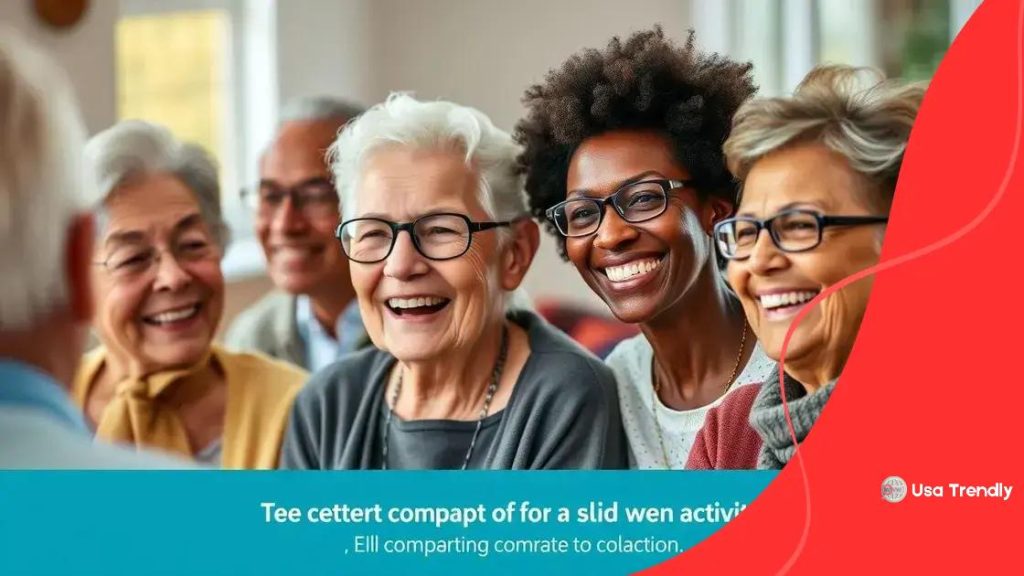Aging population incentives: why they matter now

Aging population incentives are essential policies and programs implemented by governments and businesses to support older adults in maintaining their quality of life, independence, and participation in society.
Aging population incentives are becoming increasingly vital as we adapt to our shifting demographics. How can these incentives shape the future for older adults, and why should we care? Let’s dive into this important topic together.
Understanding the aging population phenomenon
Understanding the aging population phenomenon is crucial as our society faces significant demographic shifts. With advances in healthcare and improved living standards, people are living longer. This change brings unique challenges and opportunities.
The Demographic Shift
The number of older adults is increasing rapidly. As birth rates decline and life expectancy rises, we will see a larger proportion of elderly individuals. This shift is not just a statistic; it influences every aspect of our society, from healthcare to the workforce.
Key Factors Influencing Aging
- Advancements in healthcare technology
- Better nutrition and lifestyle choices
- Increased awareness of mental health
- A shift in societal values towards family and community support
These factors play a significant role in how we perceive aging today. For example, health innovations have enabled many older adults to maintain their independence, which can lead to active participation in their communities.
The impact of an aging population extends beyond individuals; it affects families and economies. More elderly individuals can mean increased pressure on family caregivers and social services. However, it also presents a chance for leveraging the skills and experiences of older adults in the workforce.
Opportunities Presented by Aging
- Job creation in healthcare and wellness industries
- Innovation in technology to assist older adults
- Community programs focused on social inclusion
- New markets targeting >older consumers
By embracing the aging population as a vital part of our future, we can shape a society that values every life stage. Understanding these dynamics is essential for developing effective policies and programs that benefit everyone.
Key incentives for supporting the aging demographic
Key incentives for supporting the aging demographic are essential for creating a Society that values all its members. These incentives aim to enhance the quality of life for older adults, ensuring they can thrive in their communities.
Financial Incentives
Offering financial support can significantly impact the lives of older adults. Programs that provide tax benefits, pensions, or subsidies help to alleviate the financial burden many face. Such measures ensure that seniors can afford basic necessities like housing, healthcare, and nutrition.
- Tax breaks for caregivers
- Increased funding for retirement benefits
- Subsidies for home modifications
These financial incentives not only support older individuals but also encourage families to care for their elderly relatives. It creates a cycle of support within communities.
Healthcare Initiatives
Access to quality healthcare is a crucial incentive. The aging population often requires specialized medical care, and enhancing services can improve their well-being. Investing in preventative care can lead to healthier aging.
- Regular health screenings for seniors
- Programs for managing chronic conditions
- Telehealth services to increase accessibility
By ensuring healthcare is accessible and affordable, we empower older adults to maintain their independence and quality of life.
Furthermore, community engagement programs create social opportunities for seniors. Activities like volunteering, classes, and social events foster a sense of belonging. This engagement is vital in combating loneliness, which is common among older adults.
Workforce Participation
Encouraging older individuals to remain in the workforce can yield substantial benefits. Flexible work options and job training programs tailored for seniors enhance their employability, allowing them to contribute to the economy. Keeping seniors in the workforce also helps address labor shortages in various sectors.
- Job retraining programs
- Flexible working hours
- Support for entrepreneurship among seniors
The incentives aimed at supporting the aging demographic ultimately lead to a more inclusive society. By addressing their needs, we pave the way for a future where older adults can lead fulfilling lives.
Economic impacts of an aging society

The economic impacts of an aging society are significant and far-reaching. As the population ages, we see changes in workforce dynamics, healthcare costs, and consumer behavior.
Workforce Shifts
With more people entering retirement age, there will be a reduction in the available workforce. This shift can lead to labor shortages in various industries, affecting productivity. Companies may need to adapt by creating flexible work environments to retain older workers.
- Job retraining and skills development for seniors
- Incentives for businesses to hire older employees
- Implementing technology that assists older workers
These adjustments can help businesses continue to thrive despite the aging demographic.
Healthcare Costs
The aging population is expected to drive up healthcare expenditures. Older adults typically require more medical care, leading to increased demand for healthcare services. This surge can challenge public health systems and budgets, emphasizing the need for effective healthcare policies.
- Rising costs of chronic disease management
- Increased demand for home healthcare services
- Expansion of insurance programs to cover older adults
Moreover, preventative healthcare measures may help mitigate these growing costs. Investing in healthy aging initiatives can lead to overall cost savings in the long term.
Additionally, older adults contribute to the economy as consumers. Their spending habits influence markets and industries, especially in sectors like travel, healthcare, and leisure activities. As they seek products and services tailored to their needs, businesses must adapt to remain competitive.
Changing Consumer Behavior
The purchasing power of older adults is substantial, and understanding their preferences is crucial for economic growth. Companies tapping into this demographic can develop targeted marketing strategies to cater to their unique interests.
- Products focused on health and wellness
- Services that enhance mobility and accessibility
- Travel packages tailored to older travelers
In summary, the economic impacts of an aging society require comprehensive strategies to address workforce changes, healthcare costs, and evolving consumer needs. By recognizing these factors, we can create a sustainable future for all ages.
Strategies for businesses to engage with older adults
Engaging with older adults is essential for businesses seeking to tap into a growing market. Developing effective strategies can help companies cater to the unique needs of this demographic.
Understanding the Audience
First, businesses must understand the preferences and challenges that older adults face. Many older individuals value quality over quantity and often look for products and services that enhance their quality of life. Researching their interests and habits is vital for delivering the right message.
- Conduct surveys to gather insights
- Utilize focus groups for deeper understanding
- Analyze purchasing patterns specific to seniors
By understanding what older adults prioritize, businesses can tailor their offerings effectively.
Creating Accessible Products and Services
Accessibility is a crucial factor in engaging older adults. Products should be easy to use and services should account for any physical limitations. This may include designing user-friendly websites, clear labeling, and customer support tailored for older users.
- Make websites easy to navigate
- Provide large print options and clear instructions
- Ensure customer service is patient and understanding
Meeting these accessibility requirements can build trust and encourage repeat business from older adults.
Additionally, marketing strategies should reflect inclusivity. Advertising campaigns should feature older adults, showcasing them as active and vibrant members of society. This representation can help challenge stereotypes and motivate older consumers to engage with brands.
Offer Loyalty Programs and Discounts
Incentives can be particularly effective in attracting older adults. Companies can establish loyalty programs that reward seniors, leading to increased customer retention.
- Implement senior discounts on products
- Offer special promotions specifically for older adults
- Create loyalty points for frequent purchasers
Such rewards not only encourage purchases but also foster a sense of appreciation among older customers.
Finally, building community connections can enhance engagement. Businesses can host events or workshops aimed at older adults, creating a welcoming environment.
Develop Community Connections
These gatherings can serve as valuable platforms for interaction, allowing seniors to share their experiences and needs directly with businesses. Partnerships with local organizations that focus on seniors can also help businesses reach this demographic more effectively.
- Collaborate with senior centers for events
- Offer workshops on health and wellness topics
- Engage in community service initiatives aimed at seniors
By implementing these strategies, businesses can successfully engage with older adults, leading to a mutually beneficial relationship.
The role of government in fostering aging population incentives
The role of government in fostering aging population incentives is vital for ensuring that older adults can lead fulfilling lives. Effective policies and programs can enhance the quality of life for seniors and support them in their communities.
Creating Supportive Policies
Governments are responsible for creating laws and policies that support the aging population. This includes developing programs that provide financial assistance, healthcare, and social services. By making these resources accessible, governments can help older adults maintain their independence and dignity.
- Implementing pension systems that ensure financial security
- Funding healthcare programs that cater to seniors
- Supporting initiatives that encourage active aging
Such policies not only benefit individuals but also promote a more inclusive society.
Investing in Infrastructure
Another essential role of the government is investing in infrastructure that accommodates older adults. This includes creating accessible public spaces and transportation options. When cities are designed with the needs of seniors in mind, it promotes their mobility and participation in community life.
- Improving public transport to be senior-friendly
- Building age-friendly housing options
- Ensuring public spaces are safe and accessible
These investments create environments where older adults can thrive and engage with their communities.
Moreover, governments can run awareness campaigns to educate the public about the needs and contributions of older adults. Changing societal perceptions is crucial to reducing ageism and fostering a culture of respect and inclusion.
Encouraging Public-Private Partnerships
Governments can also foster collaboration between the public and private sectors. By incentivizing businesses to develop products and services for older adults, they stimulate economic growth while addressing the needs of this demographic.
- Offering tax incentives for companies targeting the aging market
- Supporting innovation in technology that assists seniors
- Promoting job training programs for older workers
Such partnerships create a more sustainable ecosystem where both the aging population and businesses can benefit.
Finally, gathering data on the aging population allows governments to make informed decisions. Conducting research and facilitating community input can help shape programs that truly reflect the needs of older adults. This evidence-based approach can lead to more effective and impactful initiatives.
aging population incentives is crucial for building a society that supports and values older adults. By creating supportive policies, investing in infrastructure, and encouraging public-private partnerships, governments can greatly improve the quality of life for seniors. Engaging older adults in community initiatives and understanding their needs allows for the development of effective programs. As we focus on these strategies, we can create opportunities that benefit not only the aging population but society as a whole.
FAQ – Questions about Aging Population Incentives
What are aging population incentives?
Aging population incentives are policies and programs designed to support older adults, helping them maintain their quality of life and independence.
How can the government support older adults?
The government can support older adults by creating supportive policies, investing in infrastructure, and promoting public-private partnerships that address their needs.
Why is community engagement important for older adults?
Community engagement helps older adults stay connected, reduces loneliness, and allows them to contribute their skills and experiences to society.
What role do businesses play in supporting older adults?
Businesses can create products and services tailored to older adults, offer discounts and loyalty programs, and engage with seniors through community initiatives.
